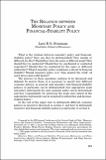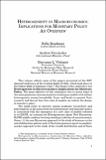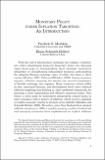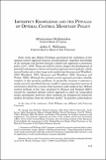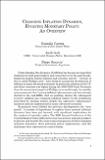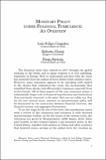Search
Now showing items 1-10 of 545
The relation between monetary policy and financial-stability policy
What is the relation between monetary policy and financialstability policy? How can they be distinguished? How similar or different are they? Should they have the same or different goals? How should they be conducted? Should they be coordinated or conducted separately? Should they be conducted by the ...
Heterogeneity in macroeconomics: implications for monetary policy an overview
This volume collects some of the papers presented at the XXV Annual Conference of the Central Bank of Chile, which took place in
November 2022 in Santiago, Chile.1 The theme of the conference was Heterogeneity in Macroeconomics: Implications for Monetary
Policy. The main objective of this conference ...
The fiscal footprint of macroprudential policy
, and this creates seignorage revenues. Inflation unexpectedly rises and this lowers the real value of public debt. Rolling over this debt is cheaper as the price of newly issued debt rises. And finally, economic activity rises, so tax revenues increase and social...
Monetary policy under inflation targeting: an introduction
With the end of intermediate exchange rate regimes, countries are either abandoning domestic monetary policy (by choosing super-hard pegs or relinquishing their national currencies altogether) or strengthening independent monetary policymaking (by adopting floating exchange rates, of either the clean ...
Independence, credibility, and communication of central banking: an overview
. Whether during the Global Financial Crisis, through individual country slumps, or at the trough of the pandemic recession, independent central banks were typically part of the solution rather than part of the problem. Attacks on the independence of a...
Imperfect knowledge and the pitfalls of optimal control monetary policy
Sixty years ago, Milton Friedman questioned the usefulness of the optimal control approach because of policymakers’ imperfect knowledge of the economy and favored instead a simple rule approach to monetary policy (1947, 1948). These are still live issues, despite the development of powerful techniques ...
Risks to central-bank independence
their power or remit. These include everything from enhanced financial regulation to quasi-fiscal policy to mitigating economic inequality. Some recent populist proposals appear to be based on the presumption that central banks can issue large quantities...
Changing inflation dynamics, evolving monetary policy: an overview
Understanding the dynamics of inflation has become an important challenge for both policymakers and researchers over the past decade. Empirical models linking inflation and economic activity—versions of the so-called Phillips curve—have failed...
Monetary policy under financial turbulence: an overview
The financial crisis that started in 2007 brought the global economy to the brink and in many respects it is still unfolding especially in Europe. How to understand and deal with the crisis has naturally been the subject of fierce debates that continue today. However some consensus appears to be ...
Monetary policy under uncertainty and learning: an overview
Central bank economists and academic economists conducting research on the design of monetary policy have made significant advances in recent years. This work has led to a clearer understanding of the desirable properties of interest rate rules, the role of announcements and communication, and the ...

